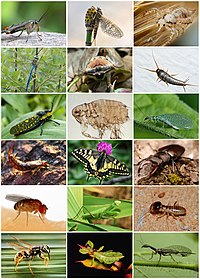
Photo from wikipedia
Abstract Geographic separation that leads to the evolution of reproductive isolation between populations generally is considered the most common form of speciation. However, speciation may also occur in the absence… Click to show full abstract
Abstract Geographic separation that leads to the evolution of reproductive isolation between populations generally is considered the most common form of speciation. However, speciation may also occur in the absence of geographic barriers due to phenotypic and genotypic factors such as chemical cue divergence, mating signal divergence, and mitonuclear conflict. Here, we performed an integrative study based on two genome‐wide techniques (3RAD and ultraconserved elements) coupled with cuticular hydrocarbon (CHC) and mitochondrial (mt) DNA sequence data, to assess the species limits within the Ectatomma ruidum species complex, a widespread and conspicuous group of Neotropical ants for which heteroplasmy (i.e., presence of multiple mtDNA variants in an individual) has been recently discovered in some populations from southeast Mexico. Our analyses indicate the existence of at least five distinct species in this complex: two widely distributed across the Neotropics, and three that are restricted to southeast Mexico and that apparently have high levels of heteroplasmy. We found that species boundaries in the complex did not coincide with geographic barriers. We therefore consider possible roles of alternative drivers that may have promoted the observed patterns of speciation, including mitonuclear incompatibility, CHC differentiation, and colony structure. Our study highlights the importance of simultaneously assessing different sources of evidence to disentangle the species limits of taxa with complicated evolutionary histories.
Journal Title: Ecology and Evolution
Year Published: 2022
Link to full text (if available)
Share on Social Media: Sign Up to like & get
recommendations!